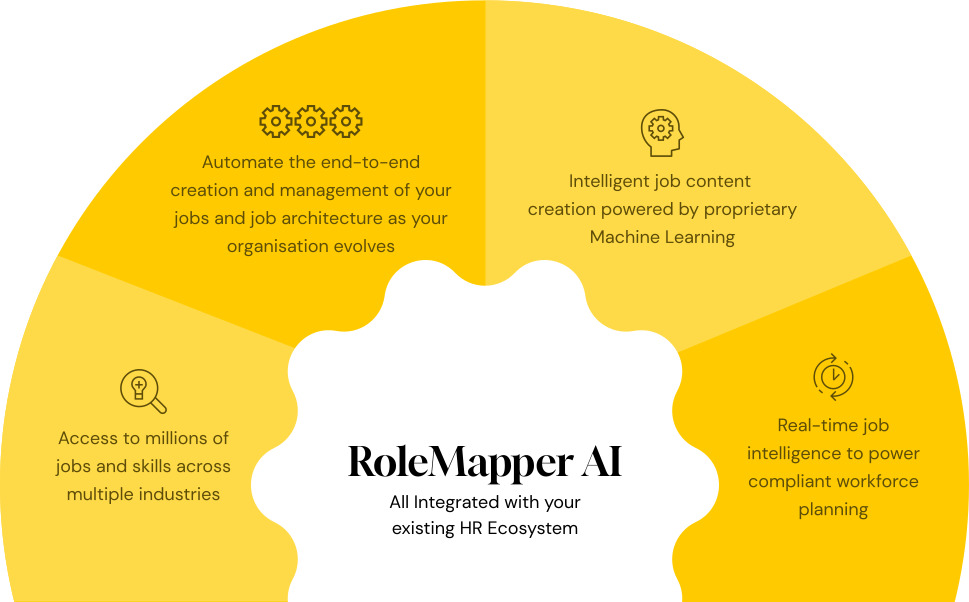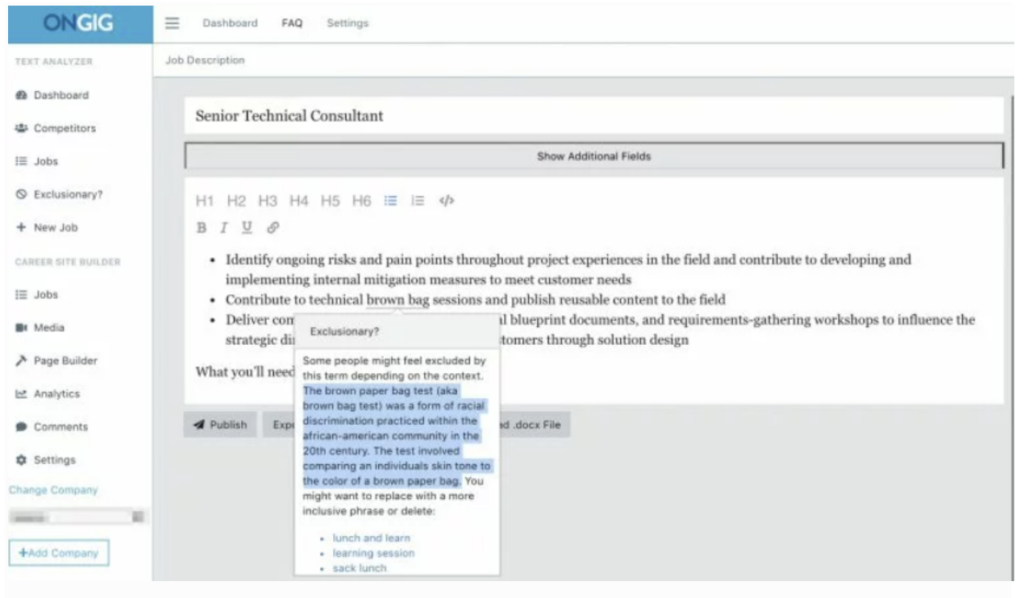- The Ultimate Guide to Job Description Templates + Helpful FAQs - April 22, 2025
- Why RoleMapper Is Changing the Way We Write Job Descriptions - April 16, 2025
- 100+ Famous Inclusive Leaders Who Helped Shape the Workplace - March 28, 2025
What’s the problem with job descriptions? Let’s be honest — most job descriptions are a mess. They’re outdated, too long, or filled with jargon that doesn’t make sense. Some are so vague that candidates have no idea what the job actually involves. Others accidentally exclude great talent by using biased language. But, you can change this with job description architecture tools like RoleMapper.
A bad job description can cost you time, money, and even your reputation. That’s where RoleMapper comes in.
What is RoleMapper?
RoleMapper is an AI-powered platform that helps businesses create clear, structured, and inclusive job descriptions. Stop copying and pasting old templates. You can use RoleMapper to build descriptions that attract the right talent while staying legally compliant.
However, it’s not just about hiring. RoleMapper also helps with job architecture, internal mobility, and pay transparency. These are things that are becoming more important in today’s workplace.
Why This Matters More Than Ever
The way we work is changing fast. Remote jobs, skills-based hiring, and diversity initiatives are reshaping how companies recruit. Therefore, job descriptions need to keep up.
So, in this blog, we’ll dive into how RoleMapper makes job descriptions smarter, fairer, and more effective. We’ll also touch on why it might be time to rethink the way your company writes them.

The Hidden Bias in Job Descriptions – How RoleMapper Can Help
How Bias Sneaks In
Most companies don’t mean to write biased job descriptions, but it happens more often than you’d think. Certain words and phrases can unintentionally discourage people from applying.
For example, words like “rockstar,” “aggressive,” or “dominant” might make some candidates — especially women and non-binary individuals — feel like they don’t belong. On the other hand, phrases like “native English speaker” could unintentionally exclude talented multilingual applicants.
These small details might not seem like a big deal, but they can have a huge impact on who applies for a job.
Fixing the Problem with RoleMapper
Providing a solution, the RoleMapper platform scans job descriptions for biased language. It also suggests more inclusive alternatives. Instead of “rockstar,” it might recommend “high-performing professional.” Instead of “native English speaker,” it could suggest “fluent in English.”
So, RoleMapper doesn’t just remove bias. It also helps you write clearer, fairer job descriptions that attract a wider, more diverse talent pool.
Why Inclusive Job Design Matters
When you take the time to create clear, structured, and inclusive job descriptions, the results speak for themselves. So, small changes in how a job is written can lead to big improvements in hiring diversity, employee retention, and overall job satisfaction.
The Impact of Inclusive Job Design
Businesses that focus on inclusive job design have seen:
- 125%+ increase in hiring diversity
- 80%+ improvement in the quality of hires
- 30% of senior roles filled by women
- 80% reduction in employee turnover
These numbers prove that better job descriptions don’t just help with hiring. They also help employees feel valued, supported, and more likely to stay long-term.
How RoleMapper Helps
With RoleMapper, you can standardize job descriptions, remove biased language, and create clear career pathways. This makes it easier to attract diverse, high-quality talent and build teams that reflect different backgrounds and perspectives.
The takeaway? Better job descriptions lead to better hires — and, thus, better workplaces.
The Science Behind Job Architecture – Why Structure Matters
Why Companies Struggle with Job Families and Career Pathways
Many companies struggle with job architecture because they don’t have a clear way to define roles, career paths, or job families. Roles often come with long lists of tasks that make it hard for candidates to see where they fit. This lack of clarity confuses job seekers, and it also makes it harder for employees to grow within a company.
When job descriptions are too complex, full of jargon, or broad, people — especially younger applicants and neurodiverse candidates — often feel discouraged from applying. A study found that 33% of job descriptions contained unclear language, and 66% of young job seekers didn’t understand the role well enough to apply.
How Structure Helps Promotions, Pay Equity, and Workforce Planning
A well-structured job description does more than attract talent. It also plays a key role in career progression, pay fairness, and workforce planning.
Clearly defining what the role holder handles and what they do, allows you to:
- Make promotions and pay raises more transparent and fair
- Ensure employees know what’s expected at each level
- Help HR and leadership plan for future talent needs
When job descriptions lack structure, employees often feel lost about how to advance in their careers. A clear job framework ensures that promotions and salary decisions are based on skills and responsibilities, not who negotiates better.
The Psychological Impact of Clear Career Paths

People want to see a future in the jobs they apply for. Therefore, when job descriptions clearly outline career growth opportunities, employees are more engaged, motivated, and likely to stay.
On the flip side, vague or overly complex descriptions make people feel like they don’t belong or aren’t “good enough” to apply. This is especially true for women, early-career professionals, and neurodiverse candidates.
That’s why best practices recommend summarizing job responsibilities in 4-5 high-level segments of work, each described in a single, clear sentence (ideally under 17 words). Research shows that concise, well-structured descriptions improve understanding and confidence among job seekers.
Studies also show that 60% of job description requirements aren’t actually essential, yet many hiring managers still include them. This often discourages diverse candidates, especially women, who tend to apply only if they meet nearly 100% of the criteria.
How RoleMapper Helps Create Inclusive Job Designs
Instead of manually sifting through responsibilities, RoleMapper’s intelligent templates help you standardize job descriptions, break them into clear segments, and remove confusing jargon. The platform even flags potential bias and suggests ways to improve inclusivity.
With a strong job architecture in place, you can build diverse, high-performing teams while ensuring employees have a clear path to success.
RoleMapper and The AI-Powered Job Description Revolution

AI is changing the way companies write job descriptions. Instead of spending hours crafting the perfect job post, hiring teams can now use AI-powered tools to generate descriptions in minutes. But is AI really making job descriptions better? And is RoleMapper leading the charge?
How AI Tools Are Transforming Job Descriptions
AI-driven job description tools like RoleMapper are designed to make writing job posts faster and more inclusive. They help break down complex responsibilities into clear, simple sections. They also highlight jargon, bias, and unnecessary requirements. These are things that might discourage qualified candidates from applying.
Instead of manually reviewing every word, you can use AI to scan for problematic language and suggest improvements. This makes the process more efficient and helps businesses attract a wider, more diverse talent pool.
RoleMapper vs. Ongig: How Do They Compare?
Both RoleMapper and Ongig use AI to improve job descriptions, but they focus on different aspects of the process.
RoleMapper is built around job design. It helps you structure roles more clearly. Thus ensuring that job descriptions align with business needs and career growth opportunities. It also analyzes language for inclusivity and clarity, making sure job descriptions appeal to a broad range of candidates.
Ongig, on the other hand, specializes in job post optimization. It uses AI to scan job descriptions for biased language, readability issues, and formatting problems. You can also customize formatting to make your job ads more engaging. Plus use custom workflows to save your team time while writing job postings.
How RoleMapper and Ongig Complement Each Other
While RoleMapper focuses on structuring job roles and responsibilities, Ongig enhances how those job descriptions are presented. Using both tools together could provide the best of both worlds.
Start with RoleMapper to define job roles, ensure clarity, and eliminate unnecessary requirements.
Then, use Ongig to refine the wording, remove biased language, and make the job post visually appealing.

Together, these tools can help companies create job descriptions that are both well-structured and engaging. So, you can attract top talent while promoting diversity and inclusion.
Can AI Really Remove Bias, or Does It Reinforce Existing Problems?
AI has the potential to reduce bias, but it’s not perfect. Many AI tools learn from existing job descriptions, which means they can accidentally reinforce biased language or outdated hiring trends. If the data AI is trained on includes biased job descriptions, the tool might replicate those same issues.
That’s why human oversight is still important. AI can flag biased language, but hiring teams need to make the final call. The best approach is a mix of AI and human judgment. So, use AI to catch hidden issues while relying on people to ensure job descriptions truly reflect your company’s values.
The Future of AI in Job Descriptions
AI isn’t replacing recruiters or hiring managers anytime soon, but it is making their jobs easier. As AI tools continue to evolve, they’ll likely get even better at spotting bias, simplifying job descriptions, and helping companies attract top talent.
For now, RoleMapper and Ongig — along with other AI-powered platforms — are changing the way businesses approach job descriptions. The real question is: Will companies use AI responsibly, or will they rely on it too much? The key is balance — letting AI do the heavy lifting while keeping human decision-making at the center of the process.
Beyond Hiring: How RoleMapper Supports Internal Mobility & Retention
Job descriptions aren’t just for hiring new employees. They can also play a major role in keeping current employees happy and engaged. When job descriptions are clear, fair, and inclusive, they help create an environment where employees can see clear paths for growth. This is especially important when it comes to internal mobility and retention. So, let’s dive into how RoleMapper can help with this.
The Overlooked Role of Job Descriptions in Employee Retention
Many companies focus heavily on recruiting, but they forget that keeping employees happy is just as important. Clear, well-defined job descriptions help employees understand their roles and what they need to do to grow within the company. Without this clarity, employees can feel stuck or uncertain about how to move up.
Job descriptions also play a key role in performance reviews and promotions. Therefore, when responsibilities are clearly outlined, employees know what is expected of them, and managers can more easily measure progress. A lack of clarity can also lead to confusion, frustration, and, ultimately, high turnover.
How RoleMapper Helps HR Teams Define Internal Career Paths
RoleMapper can help HR teams map out career paths for existing employees. With clearly defined skills, responsibilities, and experiences required for different roles, HR can create transparent career paths for employees to follow.
Using RoleMapper, HR teams can see how roles fit together within the company and define clear steps for growth. For example, an employee in a junior position might know exactly what skills and experiences they need to move into a senior role. This transparency boosts morale. That’s because employees can see exactly how to advance in their careers.
The Connection Between Transparent Job Roles and Employee Satisfaction
When employees can see what’s expected of them and how they can move forward, it creates a sense of purpose and direction. This transparency is directly linked to higher levels of employee satisfaction. Additionally, when you reward hard work with career advancement, people will want to stay with the company.
RoleMapper helps you create job descriptions that clearly outline these opportunities for growth. Whether it’s moving into a new department or taking on more responsibility in a current role, employees who understand the path to promotion are more likely to stay engaged and committed.
How RoleMapper Supports Retention Beyond Hiring
With a focus on job clarity and career progression, RoleMapper supports employee retention in powerful ways. A strong internal mobility strategy, fueled by clear job descriptions, shows employees that the company is invested in their long-term success. Therefore, when employees feel supported and see a clear future within the company, they are less likely to look for opportunities elsewhere.
So, RoleMapper doesn’t just help you hire top talent; it also helps you keep them.
The ROI of Better Job Descriptions – Can RoleMapper Save You Money?
Hiring the wrong person can be expensive. From the cost of recruiting to the impact on team morale, the financial consequences of bad hires and high turnover are huge. Creating better, clearer, and more inclusive job descriptions helps you save money in the long run. So, let’s break down how RoleMapper can give your business a strong return on investment (ROI).
The Financial Impact of Bad Hires and Turnover
Bad hires are costly, and they can disrupt the entire team. When a new hire doesn’t work out, you have to spend time and resources to find a replacement. On top of that, the impact on team performance can lead to even more expenses.
Turnover is also costly. When employees leave, companies face the cost of hiring new staff, onboarding them, and training them. According to some estimates, the cost of replacing an employee can range from 30% to 150% of their annual salary, depending on the role. This doesn’t even include the damage to company culture and the time it takes for new employees to get up to speed.
How Well-Crafted Job Descriptions Improve Hiring Efficiency
Clear, well-written job descriptions help attract the right candidates from the start. Thus, by using RoleMapper, companies can create job descriptions that are precise, inclusive, and free from bias. This means that the right people apply for the job, and the wrong people don’t waste your time.
When a job description clearly defines the skills and responsibilities of a role, candidates can easily see if they’re a good fit. This results in fewer unqualified applicants, making the recruitment process more efficient. In turn, hiring teams spend less time reviewing resumes and conducting interviews. And this saves both time and money.
Real-World Savings from Companies Using RoleMapper
RoleMapper is already helping companies save money. With a streamlined job description process, you can reduce turnover and improve hiring outcomes. In fact, businesses using RoleMapper have reported significant cost savings. That’s due to fewer bad hires, lower turnover rates, and a faster recruitment process.
For example, companies that have implemented RoleMapper’s job description platform have seen a reduction in turnover by up to 80%. So, with clearer role definitions, employees stay longer. And hiring managers can make better, more informed decisions.
Why I Wrote This
As someone who’s passionate about improving the hiring process, I’ve seen firsthand how small changes can make a big difference. Job descriptions are one of those areas that are often overlooked. Yet, they hold the power to attract the right talent, foster inclusivity, and improve retention. With tools like RoleMapper and Ongig, you can transform your hiring strategies and save money. Plus, you can start to build stronger teams.
Are you ready to take your job descriptions to the next level? Request a demo of Ongig today. See how it can help you create clearer, more inclusive job postings. Thus attracting the right candidates for your business.
Shoutouts:
- Getting Inclusive Job Descriptions Right – https://www.rolemapper.tech/blog/getting-inclusive-job-descriptions-right/
- Employee Retention: What Employee Turnover Really Costs Your Company – https://mgrworkforce.com/employers/employee-retention-costs/#:~:text=An%20entry%2Dlevel%20employee%20turnover,their%20annual%20salary%20to%20replace.
- Guide to Inclusive Job Descriptions – https://files.rolemapper.tech/hubfs/RM-Guide-To-Inclusive-Job-Descriptions.pdf
- Maximizing Recruitment ROI with More Quality Candidates – https://info.recruitics.com/blog/maximizing-recruitment-roi-with-quality-candidates
- How AI is Transforming the World of Recruitment – https://www.jobylon.com/blog/how-ai-is-transforming-the-world-of-recruitment
